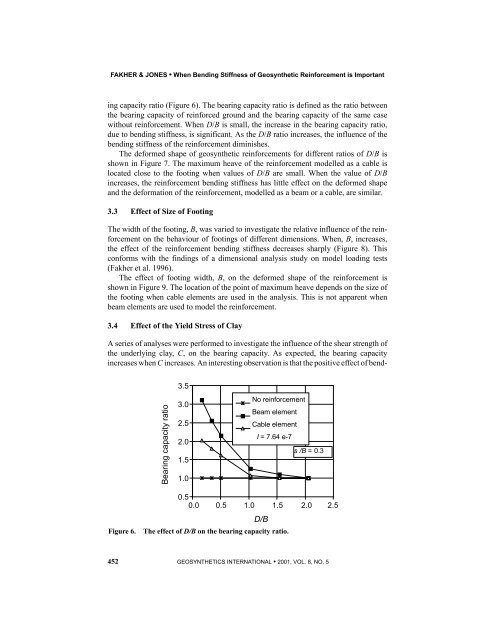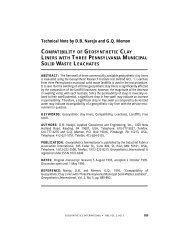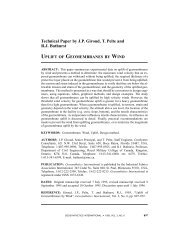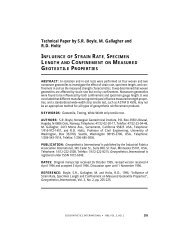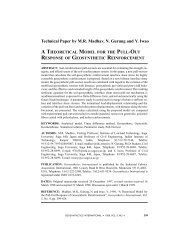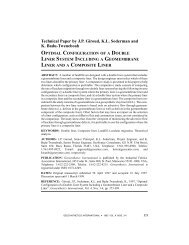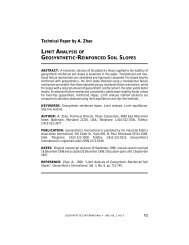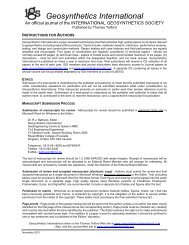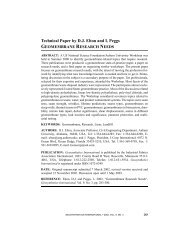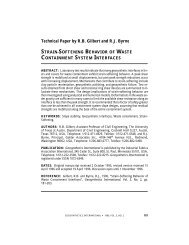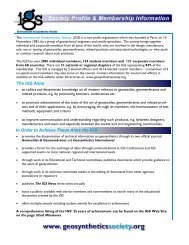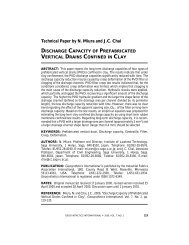Technical Paper by A. Fakher and C.J.F.P. Jones WHEN THE ...
Technical Paper by A. Fakher and C.J.F.P. Jones WHEN THE ...
Technical Paper by A. Fakher and C.J.F.P. Jones WHEN THE ...
You also want an ePaper? Increase the reach of your titles
YUMPU automatically turns print PDFs into web optimized ePapers that Google loves.
FAKHER & JONES • When Bending Stiffness of Geosynthetic Reinforcement is Important<br />
ing capacity ratio (Figure 6). The bearing capacity ratio is defined as the ratio between<br />
the bearing capacity of reinforced ground <strong>and</strong> the bearing capacity of the same case<br />
without reinforcement. When D/B is small, the increase in the bearing capacity ratio,<br />
due to bending stiffness, is significant. As the D/B ratio increases, the influence of the<br />
bending stiffness of the reinforcement diminishes.<br />
The deformed shape of geosynthetic reinforcements for different ratios of D/B is<br />
shown in Figure 7. The maximum heave of the reinforcement modelled as a cable is<br />
located close to the footing when values of D/B are small. When the value of D/B<br />
increases, the reinforcement bending stiffness has little effect on the deformed shape<br />
<strong>and</strong> the deformation of the reinforcement, modelled as a beam or a cable, are similar.<br />
3.3 Effect of Size of Footing<br />
The width of the footing, B, was varied to investigate the relative influence of the reinforcement<br />
on the behaviour of footings of different dimensions. When, B, increases,<br />
the effect of the reinforcement bending stiffness decreases sharply (Figure 8). This<br />
conforms with the findings of a dimensional analysis study on model loading tests<br />
(<strong>Fakher</strong> et al. 1996).<br />
The effect of footing width, B, on the deformed shape of the reinforcement is<br />
shown in Figure 9. The location of the point of maximum heave depends on the size of<br />
the footing when cable elements are used in the analysis. This is not apparent when<br />
beam elements are used to model the reinforcement.<br />
3.4 Effect of the Yield Stress of Clay<br />
A series of analyses were performed to investigate the influence of the shear strength of<br />
the underlying clay, C, on the bearing capacity. As expected, the bearing capacity<br />
increases when C increases. An interesting observation is that the positive effect of bend-<br />
3.5<br />
Bearing capacity ratio<br />
3.0<br />
2.5<br />
2.0<br />
1.5<br />
1.0<br />
No reinforcement<br />
Beam element<br />
Cable element<br />
I = 7.64 e-7<br />
s /B = 0.3<br />
Figure 6.<br />
0.5<br />
0.0 0.5 1.0 1.5 2.0 2.5<br />
D/B<br />
The effect of D/B on the bearing capacity ratio.<br />
452 GEOSYN<strong>THE</strong>TICS INTERNATIONAL • 2001, VOL. 8, NO. 5


